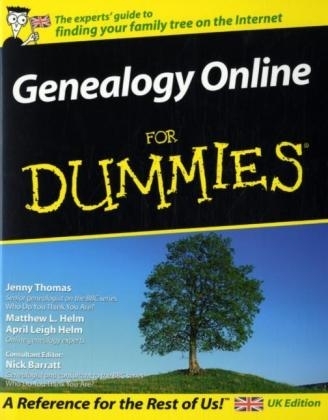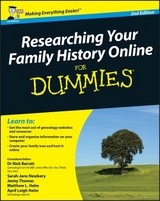
Genealogy Online For Dummies
Hungry Minds Inc,U.S. (Verlag)
978-0-7645-7061-2 (ISBN)
- Titel erscheint in neuer Auflage
- Artikel merken
Researching our family tree has become a top national pastime, and with the advent of the Internet, it's also become much faster and easier than before. As more and more information is placed online, you can afford to relax and research in the comfort of your own home, at your convenience. The only problem is where - and how - do you start? "Genealogy Online For Dummies" gives you expert guidance, from Nick Barratt, the genealogy expert on the BBC's 'Who Do You Think You Are?' programme, on how to start building your family tree, where to look for clues, how to discover the most useful websites and how to use and organise the information that you find. "Genealogy Online For Dummies" includes: laying the groundwork; planning for genealogical success; fine-tuning your organizational and preservation skills; starting to build your family tree; what's in a name?; locating your ancestors (geographically speaking); getting to know what you are looking for; starting offline: basic genealogical sources in the uk; going online: searching official and commercial websites; storing and organizing information in your computer; coordinating your attack: getting help from other researchers; sharing your wealth online; creating a place to call home; ten handy databases; ten things to remember when designing your genealogical web site; and, ten sites that offer help.
Jenny Thomas is a genealogist and historian, and the senior researcher on the BBC series Who Do You Think You Are? Matthew L. Helm and April Leigh Helm manage several leading online genealogical resources. April Leigh Helm is the President of FamilyToolbox.net, Inc. April lectures on genealogy and other topics for various conferences and groups. She holds a B.S. in Journalism and an Ed.M. in Higher Education Administration from the University of Illinois at Urbana-Champaign. Nick Barratt is the genealogical consultant for Who Do You Think You Are? and runs his own research agency.
Introduction. Part I: Starting at the Roots. Chapter 1: Laying The Groundwork. Chapter 2: Planning for Genealogical Success. Chapter 3: Fine-Tuning Your Organizational and Preservation Skills. Part II: Focusing on Your Ancestors. Chapter 4 : What's in a Name?. Chapter 5: Locating Your Ancestors (Geographically Speaking). Part III: Rooting Around in the Past. Chapter 6: Getting to Know What You Are Looking For. Chapter 7: Starting Offline: Basic Genealogical Sources in the UK. Chapter 8: Online access and collections. Part IV: Share and Share Alike. Chapter 9 : Storing and Organizing Information in Your Computer. Chapter 10 : Coordinating Your Attack: Getting Help from Other Researchers. Chapter 11 : Sharing Your Wealth Online. Chapter 12: Creating a Place to Call Home. Part V: The Part of Tens. Chapter 13 : Ten Handy Databases. Chapter 14 : Ten Things to Remember When Designing Your Genealogical Web Site. Chapter 15 : Ten Sites That Offer Help. Appendix A: Going Online. Appendix B: What Does This Mean? (A Glossary of Terms). Index. Table of Contents. Introduction. About This Book. Foolish Assumptions. How to Use This Book. How This Book Is Organized. Part I: Getting Your Act Together. Part II: Focusing on Your Ancestor. Part III: Finding the Records of Your Family History. Part IV: Share and Share Alike. Part V: The Part of Tens. Appendixes. The Genealogy Online For Dummies Internet Directory. Icons Used in This Book. Where to Go from Here. Part I: Starting at the Roots. Chapter 1: Laying The Groundwork. Building your family tree. Understanding relationships. Constructing a family tree. Starting Your Research with What You Already Know. Making a few notes about yourself - the biographical sketch. Finding primary sources. Chatting with Dad and Aunty Doris: Interviewing Your Family Members. Looking for Love Letters, Laundry Receipts,. and Other Important Documents. Dusting Off the Old Photo Albums. Sifting Through Birth, Death, Marriage, and Divorce Records. Birth records. Marriage records. Divorce records. Death records. Coming to Your Census. Location, Location, Location: Researching Land Records. Trial and Error at the Courthouse. Visiting Libraries, Archives, and Historical Societies. Getting Involved with Genealogical Societies. Working with the World Wide Web. Using shareware and online packages. Finding useful Web sites. Interpreting What You Uncover. Chapter 2: Planning for Genealogical Success. Starting Your Research. Setting your research goals. Keeping your expectations realistic. Introducing the Family History Research Cycle. Planning your research. Collecting useful information. Researching: Through the brick wall and beyond. Using a database to consolidate your information. Distilling the information that you gather. Selecting a Person to Begin Your Search. Trying a unique name. Using a person who you know about. Selecting a grandparent's name. Too Many Ancestor Irons in the Research Fire. Chapter 3: Fine-Tuning Your Organisational and. Preservation Skills. Getting a Firm Foundation in Traditional Methods. of Genealogical Organisation. Establishing good organisational skills. Understanding genealogical charts and forms. Assigning unique numbers to family members. Making copies of source documents. Deciding on a storage method. Preserving Your Treasured Family Documents. Storing vital records under the right conditions. Protecting your photographs. Part II: Focusing on Your Ancestors. Chapter 4: What's in a Name?. Finding the Site That's Best for You. Personal genealogical sites. One-name study sites. Family associations and organizations. Surnames connected to events or places. Taking the Plunge. Family Trees Ripe for the Pruning (Finding Compiled. Genealogical Resources). Narrative compiled genealogies. Compiled genealogical databases. Letting Your Computer Do the Walking: Using Search Engines. Focusing on genealogically focused search engines. Using general Internet search engines. Looking at general Internet meta-search engines. Online Subscription Databases: Gold Mines of Genealogy?. Browsing Comprehensive Genealogical Indexes. Integrated Genealogical Search Sites. Query for One: Seeking Answers to Your Surname Questions. Web queries. Mailing-list queries. Using E-Mail to Get Help. The Roots Surname List. Surname-related e-mail resources. Verifying Your Information: Don't Believe Everything You Read!. Chapter 5: Locating Your Ancestors. (Geographically Speaking). Are We There Yet? (Researching Where 'There'. Was to Your Ancestors). Using documentation you already have in your possession. Grilling your relatives about what they know. Where is Llandrindod, anyway?. Mapping your ancestor's way. Positioning your family: Using global positioning systems. Plotting against the family. There's No Place Like Home: Using Local Resources. Geographic-specific Web sites. Genealogical and historical societies. Libraries and archives. Professional researchers. Looking at directories and newspapers. Localizing your search. Hit the Road, Jack! (Planning Your Genealogy Travels Using the Web). Part III: Rooting Around in the Past. Chapter 6: Getting to Know What You're Looking For. Basic Genealogical Sources in the UK. Counting on the Census. Getting the lowdown on censuses. Finding your ancestors in census records. Civil Registration Sources. Wills and Probate Documents. Parish Registers. Extending Your Research. Marching to a Different Drummer: Searching for Military Records. Service records. Pension records. Locating military records. Working on Workplace Records. Investigating Immigration and Naturalization Records. Was Your Ancestor a Criminal? Using Court Records. Records Off the Beaten Path. If The Walls Could Speak: Evidence from House and Home. A Photo Is Worth a Thousand Words. Adoption Records. It's in the Genes: Molecular Genealogy. Chapter 7: Starting Offline: Basic Genealogical Sources in the UK. Locating Your Sources. Visiting Offline Resources. Looking in at libraries and local study centres. Finding family history centres. Courting county and municipal archives. Navigating through national collections. Aiming for archives overseas. Working in Record Offices. Finding an appropriate centre. Understanding the rules and regulations. Online access and collections. Chapter 8: Going Online: Searching Official and Commercial Websites. Letting Your Computer Do the Walking. Software packages. Costs: Online fees and subscriptions. Using Official and Commercial Web sites. Official registration. Citing census returns. Working with wills and probate. Looking through parish registers. Accessing other collections online. Casting Your (Inter)net Wider. Using a search engine. Looking for surname data. Finding information on personal websites. Identifying a good site. Contacting the webmaster. Sharing information: Considering copyright issues. Understanding online etiquette. Delving into discussion groups. Making the most of mailing lists. Negotiating newsletters andOnline publications. Direct Insert: The Genealogy Online For Dummies Internet Directory. Part IV: Share and Share Alike. Chapter 9 : Storing and Organizing Information. in Your Computer. Finding and Running Genealogical Software. Finding a Research Mate (Of the Software Variety). Sharing Your Genealogical Success with Others. Pedigree charts (or Ancestor Trees). Descendant charts. Outline reports. Family Group Sheets. Kinship reports. Formatting and customizing charts and reports. Let's Talk Hardware: Is Your Computer Equipped?. Writable CD-ROM or DVD drives. Sound cards. Video-capture boards. Scanners. Digital cameras. Travelling with Your Genealogical Tools. Portable databases. Storage on the run. Chapter 10 : Coordinating Your Attack: Getting Help. from Other Researchers. Putting All Your Eggs in One Basket: Relying Only on. Your Research. The Shotgun Approach. Making Friends (And Keeping Them) Online. Forming Research Groups. Becoming a Solid Member of (Genealogical) Society. Geographical societies. Family and surname associations. Reuniting with Your Family (Family Reunions as a Research Occasion). Rent-A-Researcher. Chapter 11 : Sharing Your Wealth Online. Why Would Anyone Want Your Stuff?. Spreading the Word on What You Have. Masterminding a surname marketing plan. Contacting your target audience. Exporting Your Information. GEDCOM files. Reports. If You Post It, They Will Come. Citing Your Sources. Mandatory Lecture on Privacy. Chapter 12: Creating a Place to Call Home. Home Sweet Home. Commercial Internet service providers. Free Web-hosting services. Do You Speak HTML?. What does HTML look like?. Some basic tags for writing your own HTML. Writing some HTML. Using an HTML editor. Using tutorials or online HTML editors. A Little Help from Some Genealogical Software Utilities. Deciding Which Treasures to Include. Part V: The Part of Tens. Chapter 13 : Ten Handy Databases. To be replaced by UK equivalents. Chapter 14 : Ten Things to Remember When Designing. Your Genealogical Web Site. Be Unique - Don't Copy Other Web Sites. Include the Surnames That You're Researching. and Provide Your Contact Information. Make It Attractive Without Being Too Flashy. Be Careful What You Post. Always Cite Your Sources. Not All Web Browsers Are Created Equal. Check and Recheck Your Links. Market Your Genealogical Web Site. Helping Others Is Its Own Reward. Where to Go for Help. Chapter 15 : Ten Sites That Offer Help. To be replaced by UK equivalents. Appendix A: Going Online. Is Your Computer Ready to Go Online?. Modem on up. Don't forget a telephone line. Getting an Internet Service Provider. Access from work or school. Direct connection to the Internet. Commercial Internet service providers. Freenets. Types of Internet Resources. E-mail. Mailing lists. File Transfer Protocol. Gopher. Newsgroups. World Wide Web. Web browsers. Search engines. Chat rooms. Appendix B: What Does This Mean?. (A Glossary of Terms). Index.
| Erscheint lt. Verlag | 13.10.2006 |
|---|---|
| Zusatzinfo | Illustrations |
| Verlagsort | Foster City |
| Sprache | englisch |
| Maße | 187 x 234 mm |
| Gewicht | 592 g |
| Themenwelt | Geschichte ► Hilfswissenschaften ► Genealogie |
| Mathematik / Informatik ► Informatik ► Web / Internet | |
| ISBN-10 | 0-7645-7061-7 / 0764570617 |
| ISBN-13 | 978-0-7645-7061-2 / 9780764570612 |
| Zustand | Neuware |
| Haben Sie eine Frage zum Produkt? |
aus dem Bereich

